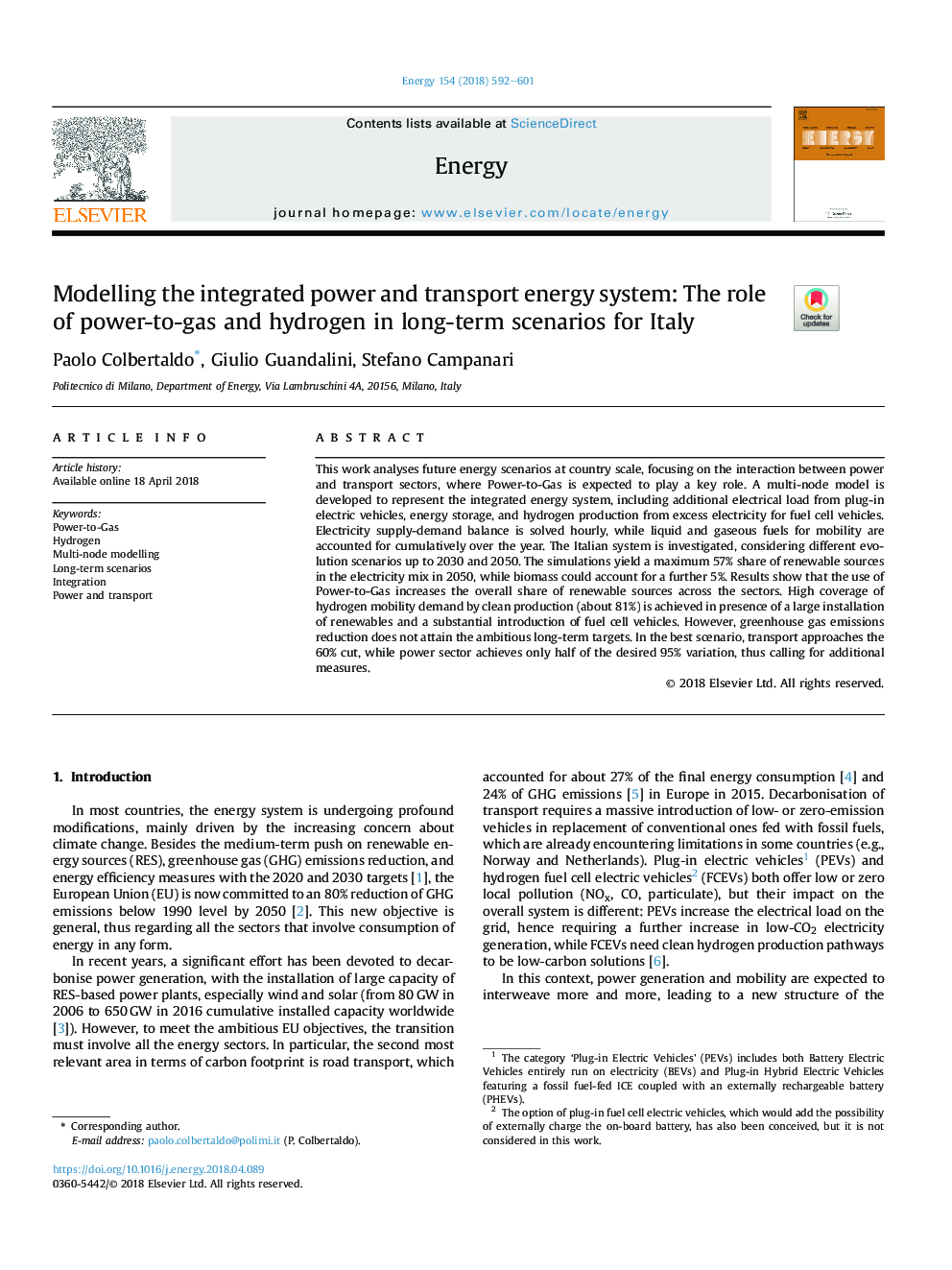| کد مقاله | کد نشریه | سال انتشار | مقاله انگلیسی | نسخه تمام متن |
|---|---|---|---|---|
| 8071521 | 1521396 | 2018 | 10 صفحه PDF | دانلود رایگان |
عنوان انگلیسی مقاله ISI
Modelling the integrated power and transport energy system: The role of power-to-gas and hydrogen in long-term scenarios for Italy
ترجمه فارسی عنوان
مدل سازی انرژی یکپارچه انرژی و سیستم حمل و نقل: نقش قدرت به گاز و هیدروژن در سناریوهای بلندمدت برای ایتالیا
دانلود مقاله + سفارش ترجمه
دانلود مقاله ISI انگلیسی
رایگان برای ایرانیان
کلمات کلیدی
برق به گاز، هیدروژن، مدل سازی چند گره سناریوهای بلند مدت، ادغام، قدرت و حمل و نقل،
ترجمه چکیده
این کار، سناریوهای انرژی آینده را در مقیاس کشور مورد تجزیه و تحلیل قرار می دهد، و تمرکز بر تعامل بین بخش های انرژی و حمل و نقل، که انتظار می رود که نیروی به گاز نقش کلیدی ایفا کند. یک مدل چند گره ای برای نشان دادن یک سیستم انرژی مجتمع، از جمله بار اضافی الکتریکی از وسایل الکتریکی پلاگین، ذخیره انرژی، و تولید هیدروژن از برق اضافی برای وسایل نقلیه سوختی توسعه یافته است. تعادل عرضه و تقاضا برای برق هر ساعته حل می شود، در حالی که سوخت های مایع و گاز برای تحرک به طور انباشت در طول سال به حساب می آیند. سیستم ایتالیایی با در نظر گرفتن سناریوهای تکاملی متفاوت تا سال 2030 و 2050 مورد بررسی قرار می گیرد. شبیه سازی ها حداکثر 57 درصد از منابع تجدید پذیر در ترکیب برق را در سال 2050 تولید می کنند، در حالی که زیست توده می تواند 5 درصد بیشتر باشد. نتایج نشان می دهد که استفاده از برق به گاز سهم کل منابع تجدیدپذیر در بخش های مختلف را افزایش می دهد. پوشش بالای تقاضای انتقال هیدروژن توسط تولید تمیز (حدود 81٪) در حضور نصب و راه اندازی انرژی های تجدید پذیر و معرفی قابل توجهی از وسایل نقلیه سوخت حاصل می شود. با این حال، کاهش انتشار گازهای گلخانه ای به اهداف بلندمدت بلند مدت نمی رسند. در بهترین حالت، حمل و نقل نزدیک به 60 درصد کاهش می یابد، در حالیکه بخش برق تنها نیمی از تغییرات مورد نظر 95 درصد را به دست می آورد، بنابراین نیاز به اقدامات اضافی دارد.
موضوعات مرتبط
مهندسی و علوم پایه
مهندسی انرژی
انرژی (عمومی)
چکیده انگلیسی
This work analyses future energy scenarios at country scale, focusing on the interaction between power and transport sectors, where Power-to-Gas is expected to play a key role. A multi-node model is developed to represent the integrated energy system, including additional electrical load from plug-in electric vehicles, energy storage, and hydrogen production from excess electricity for fuel cell vehicles. Electricity supply-demand balance is solved hourly, while liquid and gaseous fuels for mobility are accounted for cumulatively over the year. The Italian system is investigated, considering different evolution scenarios up to 2030 and 2050. The simulations yield a maximum 57% share of renewable sources in the electricity mix in 2050, while biomass could account for a further 5%. Results show that the use of Power-to-Gas increases the overall share of renewable sources across the sectors. High coverage of hydrogen mobility demand by clean production (about 81%) is achieved in presence of a large installation of renewables and a substantial introduction of fuel cell vehicles. However, greenhouse gas emissions reduction does not attain the ambitious long-term targets. In the best scenario, transport approaches the 60% cut, while power sector achieves only half of the desired 95% variation, thus calling for additional measures.
ناشر
Database: Elsevier - ScienceDirect (ساینس دایرکت)
Journal: Energy - Volume 154, 1 July 2018, Pages 592-601
Journal: Energy - Volume 154, 1 July 2018, Pages 592-601
نویسندگان
Paolo Colbertaldo, Giulio Guandalini, Stefano Campanari,
